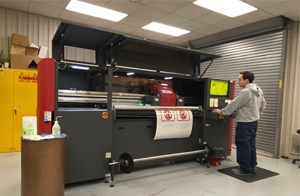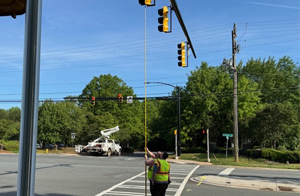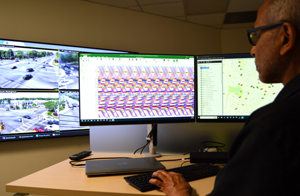Operations, Implementation and Signal System
Operations

The Operations team is responsible for installing and maintaining:
- Traffic Signals.
- Video cameras and loop detectors at signalized intersections to identify stopped or approaching vehicles and bicycles.
- Signs and pavement markings.
Additionally, this team creates approximately 2,600 signs installed on city streets each year. Examples of these are:
- Regulatory signs (yield, speed limit, turn prohibition, parking, etc.).
- Warning signs (curve, intersection, speed hump, chevrons, etc.).
- Guide signs (street name, school, park, etc.).
- Special signs (neighborhood watch, etc.).
Staff Contacts
Engineering & Operations Division Manager - David Smith
Engineering & Operations Deputy Division Manager - Bryan Tarlton
Signal Systems Manager - Nathan Conard
Implementation Manager - Martin Brown
Traffic Safety Manager - Geoff Sloop
Implementation

The Implementation team creates new traffic signal installations, designs modification(s) to existing traffic signal installations, and processes new traffic control plans for thoroughfare lane and street closures associated with roadway and intersection improvement projects. This includes designing signs and pavement marking plans for these projects as well as coordinating their installation.
This team is also responsible:
- Installation and modification of Pedestrian Hybrid Beacons (PHBs) and Rectangular Rapid Flashing Beacons (RRFBs).
- Oversight and administration of traffic signal projects related to private development.
- Management of city-maintained bridges.
- Inspection and upgrade of railroad crossings.
Signal Systems

The Signal Systems team is responsible for operating traffic signals, pedestrian signals and coordinated signal systems within the city. Staff monitor traffic conditions and issue traffic incident alerts during peak traffic hours. The signal system currently includes:
- 900+ signalized intersections.
- Video detection and in-pavement loops at signalized intersections to detect approaching cars, motorcycles and bicycles.
- Traffic signal preemption system along South Boulevard and North Tryon Street for LYNX Blue Line light rail.
- Traffic signal prioritization system for the Charlotte Fire Department.
This team is also responsible for the design, construction and maintenance of the city's Intelligent Transportation System (ITS) infrastructure. It consistently updates the program strategy with new and emerging technologies. The primary ITS components include:
- 400+ miles of fiber optic cable networking traffic infrastructure.
- 500+ traffic surveillance video cameras.
- Analog and digital communication infrastructure.